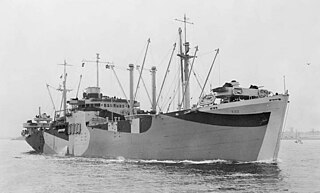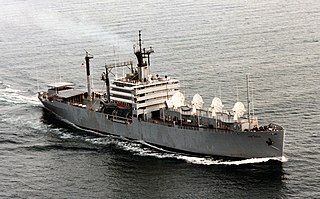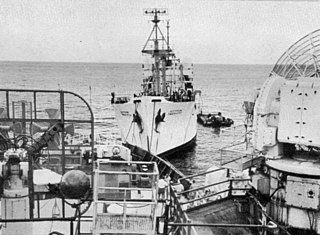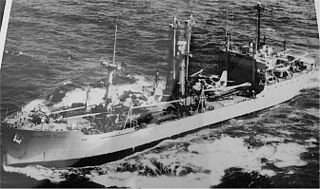
USNS Watertown (T-AGM-6) was a Watertown-class missile range instrumentation ship acquired by the United States Navy in 1960 and converted from her SS Niantic Victory Victory ship cargo configuration to a missile tracking ship, a role she retained for eleven years before being placed out of service in 1971.

Type C1 was a designation for cargo ships built for the United States Maritime Commission before and during World War II. Total production was 493 ships built from 1940 to 1945. The first C1 types were the smallest of the three original Maritime Commission designs, meant for shorter routes where high speed and capacity were less important. Only a handful were delivered prior to Pearl Harbor. But many C1-A and C1-B ships were already in the works and were delivered during 1942. Many were converted to military purposes including troop transports during the war.

USNS Observation Island (T-AGM-23) was built as the Mariner-class merchant ship Empire State Mariner for the United States Maritime Commission, launched 15 August 1953, and operated by United States Lines upon delivery on 24 February 1954, making voyages for the Military Sea Transportation Service (MSTS) until going into reserve at Mobile, Alabama on 9 November 1954.

A tracking ship, also called a missile range instrumentation ship or range ship, is a ship equipped with antennas and electronics to support the launching and tracking of missiles and rockets. Since many missile ranges launch over ocean areas for safety reasons, range ships are used to extend the range of shore-based tracking facilities.

SS Twin Falls Victory, named after Twin Falls, Idaho, was a Victory ship built for World War II. Converted to a Missile Range Instrumentation Ship, she was initially operated by the US Air Force as USAF Twin Falls Victory, before coming under US Navy control and being named USNS Twin Falls (T-AGM-11/T-AGS-37). She later had a third career as the training ship SS John W. Brown II.

USNS General Hoyt S. Vandenberg (T-AGM-10) was a General G. O. Squier-class transport ship in the United States Navy in World War II named in honor of U.S. Army Chief of Engineers Harry Taylor. She served for a time as army transport USAT General Harry Taylor, and was reacquired by the navy in 1950 as USNS General Harry Taylor (T-AP-145).

USNS General H. H. Arnold (T-AGM-9) was a General G. O. Squier-class transport ship for the U.S. Navy in World War II. She was named in honor of U.S. Army general Robert Emmet Callan. She was transferred to the U.S. Army as USAT General R. E. Callan in 1946. On 28 April 1950 she was transferred to the Military Sea Transportation Service (MSTS) as USNS General R. E. Callan (T-AP-139). Placed in reserve in 1958, she was transferred to the U.S. Air Force in 1961 and renamed USAFS General H. H. Arnold in 1963, in honor of Henry H. Arnold, the first and only General of the Air Force. She was reacquired by the Navy in 1964 as USNS General H. H. Arnold (T-AGM-9). She was struck from the Naval Vessel Register on 1 March 1982.

USNS Range Recoverer (T-AG-161/T-AGM-2/YFRT-524) was a missile range instrumentation ship responsible for providing radar and/or telemetry track data on missiles launched from American launch sites.

SS Haiti Victory (T-AGM-238) was originally built and operated as Greenville class cargo Victory ship which operated as a cargo carrier in both the Atlantic Ocean and the Pacific Ocean during World War II.

USNS Private Joe E. Mann (T-AK-253) was a Boulder Victory-class cargo ship acquired in 1950, from the U.S. Army, where she was known as the USAT Private Joe E. Mann.

SS Dalton Victory was built as Victory ship used as a cargo ship for World War II under the Emergency Shipbuilding program. She was launched by the California Shipbuilding Company on 6 June 1944 and completed on 19 July 1944 as a Greenville Victory-class cargo ship. The ship’s United States Maritime Commission designation was VC2- S- AP3, hull number 21. She was acquired by the U.S. Navy in 1950 and renamed the USNS Dalton Victory (T-AK-256).
USS Somerset (AK-212) was an Alamosa-class cargo ship that was constructed for the US Navy during the closing period of World War II. She was later acquired by the US Army in 1946 and the US Air Force in 1957 before being reacquired by the USN as the USNS Coastal Sentry (T-AGM-15), a missile range instrumentation ship.

USNS Coastal Crusader (AK-220/ORV-16/T-AGM-16/AGS-36) was an Alamosa-class cargo ship that was constructed for the US Navy during the closing period of World War II. She was later acquired by the US Army in 1946 and the US Air Force in 1957 before being reacquired by the USN in 1964 and as a missile range instrumentation ship.

USNS Timber Hitch (T-AGM-17) was a US Navy missile range instrumentation ship which earlier operated as the US Air Force Ocean Range VesselUSAFS Timber Hitch (ORV-17) on the US Air Force's Eastern Test Range during the late 1950s and early 1960s. Timber Hitch operated under an Air Force contract with Pan American Airways Guided Missile Range Division headquartered in Cocoa Beach, Florida.
USNS Sgt. Joseph E. Muller was a C1-M-AV1 cargo ship completed 9 June 1945 and delivered to the War Shipping Administration (WSA) as Check Knot. After operation by WSA's agent Waterman Steamship Company June 1945 – November 1946 and being placed in reserve the ship was transferred to the U.S. Army and renamed USAT Sgt. Joseph E. Muller. She was transferred to the United States Navy in 1950 after the establishment of the Military Sea Transportation Service under Navy and assigned to Korean War supply and transport operations. She was again place back in service in 1962 as one of the civilian crewed, Auxiliary General (AG), technical research ships working on National Security Agency/Naval Security Group missions, based out of Florida. She was finally declared surplus to needs in 1969 and struck.

USNS Sgt. Curtis F. Shoup (T-AG-175) was a C1-M-AV1 coastal freighter. Built as Spindle Eye, one of the many named for knots. The ship, modified to be a "news transmission ship" for the press during the planned invasion of Japan, was completed 9 July 1945, delivered to the War Shipping Administration and placed under its agent Lykes Brothers Steamship Company the same day. Days later, on 26 July, Spindle Eye was bareboat chartered to the War Department for operation by the Army. The ship was renamed November 1947 by the Army, after serving as a radio relay ship at the Operation Crossroads atomic bomb tests and conversion to an Army passenger-cargo vessel, Sgt. Curtis F. Shoup in honor Sergeant Curtis F. Shoup who had been awarded the Medal of Honor.

USNS Colonel William J. O’Brien (T-AK-246) was a US Maritime Administration (MARCOM) C1-M-AV1 type coastal cargo ship, originally planned as an Alamosa-class cargo ship. Constructed as Maiden's Eye for the MARCOM, completed in August 1945 and placed in operation by the War Shipping Administration (WSA). After the war Maiden's Eye was transferred to the US Army and renamed USAT Colonel William J. O’Brien who kept her in service until transferred to the US Navy in 1950 for operation as USNS Colonel William J. O’Brien (T-AK-246) by the Military Sea Transportation Service (MSTS) until 1973.
USNS Private John F. Thorson (T-AK-247) was a US Maritime Administration (MARCOM) C1-M-AV1 type coastal cargo ship, originally planned as an Alamosa-class cargo ship. Constructed as Becket Bend for MARCOM, completed in August 1945 and placed in operation by the War Shipping Administration. However, the war ended, and she was transferred to the US Army as USAT Private John F. Thorson who kept her in service until transferred to the US Navy in 1950. She was struck in 1960, ending her military career.

USNS Private Frank J. Petrarca (T-AK-250) was a US Maritime Administration (MARCOM) C1-M-AV1 type coastal cargo ship, originally planned as an Alamosa-class cargo ship. Constructed as Long Splice for MARCOM, completed in September 1945 and placed in operation by the War Shipping Administration (WSA) during the closing period of World War II. However, the war ended, and she was transferred to the US Army as USAT Private Frank J. Petrarca who kept her in service until transferred to the US Navy in 1950.
















